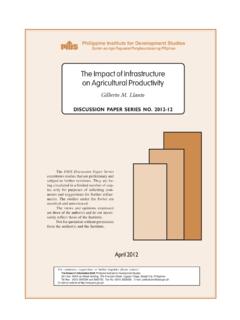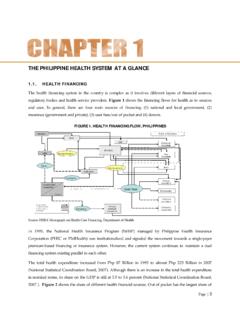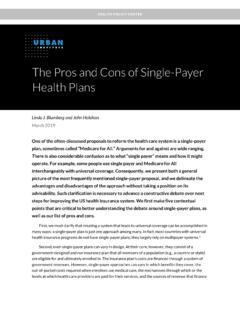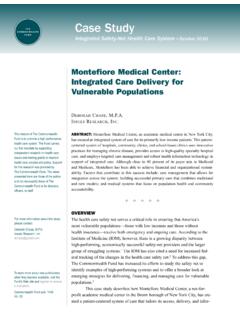Transcription of The National Health Insurance Act of the Philippines ...
1 The National Health Insurance Program in the Philippines : Critical Challenges and Future Directions PIDS HSRM Knowledge-Sharing Seminar 01 July 2014, PIDS, Makati City Maricel T. Fernandez Alex B. Brillantes Jr Abigail Modino Main Messages of the Paper Access to Health care not only promotes good Health and longevity, but as an investment in human capital, also contributes to labor force productivity, employment and, eventually, economic growth in the long run (PDP, 2011) Universal Health care has been a value articulated by recent administrations and been given priority by the Aquino Administration Earlier on, there were attempt to pass UHC policies beginning with Medicare and the Primary Health Care Act in 1979. Since then, a number of laws have been passed the landmark legislation of which was the National Health Insurance Act of 1995 (Republic Act 7875). The latest law was the National Health Insurance Act of 2013 (Republic Act10606) passed in July 2013. Before the passage of RA 10606, the study team was commissioned (May 2013 to May 2014) to identify areas of potential improvement for RA 7875 and RA 9241.
2 The study team discovered that a number of proposed bills pending in Congress were actually addressing areas of reform and improvement specifically in the following areas: administrative, operational and financing As the study was being conducted, RA 10606 was passed. It was within this context that the study examined the new law and whether it actually addressed the areas of improvement included in the proposed bills The new law (RA 10606) is an improvement of the former laws (RA 7875 and 9241). More specifically, the new law provides improvements and reforms in the following areas: Membership classification (Membership classification has been changed to capture those previously unenrolled) Source of premium: (the contributions of those identified by the NHTS are covered by the National government. The LGUs cover those still in the poor segment but not covered by NHTS) Role of LGU: SPHEAR (Sponsor, Payer, Health Care Provider, Employer, Advocate, Regulator) VP Greg Rulloda of Philhealth The enabling framework for improvement and reform of the NHIP has been set.
3 The challenge in meaningful implementation Paper Outline Rationale and Background Objectives Methodology and Initial Review of Previous Studies Overview of the Health Sector in the Philippines The National Health Insurance Program and Related Laws and Policies on Health The National Health Insurance Act of 1995 (Republic Act 7875) The National Health Insurance Act of 2013 (Republic Act 10606) The NHIP Experience (best practices in Luzon, Visayas & Mindanao) Emerging Issues and Next Steps Objectives of the study This study seeks to: Analyse the status of the implementation of the NHIA of 1995 and other social Health Insurance policies/programs in the Philippines ; Identify some best practices on SHI in the region; Identify emerging contemporary issues and concerns in the social Health Insurance ; and Recommend appropriate policies that may be adopted to improve Health Insurance in the Philippines . Objectives of the study Further objective Study the new provisions of the recently enacted Republic Act 10606 or the National Health Insurance Act of 2013 Methodology Extensive review of documents and bills pending in both houses of congresses that aim to reform and improve the public Health Insurance system in the Philippines ; Extensive review of the National Health Insurance Act (NHIA) of 1995 and the National Health Insurance Act (NHIA) of 2013 and their corresponding IRRs; and Focused group discussions and key informants interviews with stakeholders at the National and local levels.
4 Rationale and Background of the Study Health Insurance in the Philippines is relatively new. The long term effects of comprehensive Health Insurance are still to be measured and felt. Philippine experience in social Health Insurance has not fared well comparing to our neighbors in Asia The challenge to fulfill the universal Health care (Kalusugang Pangkalahatan). Overview of the Health Sector in the Philippines unequal access to Health services and the large share of household out of pocket spending in total Health expenditures. (Manasan, 2011). Overview of the Health Sector in the Philippines On meeting the MDGs Reduce by two-thirds between the under-five mortality rate Improve maternal Health Combat HIV/AIDS, malaria and other diseases. It is unlikely that the Philippines will be able to meet some of its target by 2015 (NSCB) A Background of the Philippine Health Sector The KASAPI (Kalusugang Sigurado at Abot Kaya sa PhilHealth Insurance )- program of Philhealth as a strategy to make healthcare more accessible to the poor (Llanto, 2007) The role of subnational institutions (local governments) in providing services to the poor within a decentralized framework (Capuno, 2006) The National Health Insurance Act and Related Policies A look at the Health policies Section 15, Art.
5 2 of the 1987 Constitution provides that the state shall protect and promote the right to Health of the people. The Primary Health Care (PHC, 1979) was created to provide basic Health care services. Executive Order No. 851 to integrate preventive, curative and rehabilitative components of Health care delivery in the country (1982) Executive Order 119 (1987) reorganization of the Ministry of Health and attached agencies Republic Act 6675 or the Generics Act of 1988. Republic Act 7160 or the Local Government Code of 1991 (LGC). National Health Insurance Act of 1995 A look at the Health policies 1999 Health Sector Reform Agenda 1999 Executive Order 102 instituted changes and operations of the DOH RA 9271 The Quarantine Act of 2004 FOUR mula One (F1) for Health (2005) RA 9502 Universally Accessible Cheaper and Quality Medicines Act (2008) RA 9711 Food and Drug Administration Act (2009) The Aquino Health Agenda (AHA) (2010) RA 1035 Sin Tax Law (2012) RA 10606 NHIA of 2013 The NHIP Republic Act of 7875 or otherwise known as National Health Insurance Act of 1995 Provides for the creation of the Philippine Health Insurance Corporation The program aims to cover all Filipino citizens but not compulsory 18 Legislative History of NHIP Republic Act 7875 February 14, 1995 Republic Act 9241 February 10, 2004 Republic Act 10606 June 19, 2013 Universal Health Care Philhealth membership by program 0%10%20%30%40%50%60%70%80%90%100%2001200 2200320042005200620072008200920102011 OFWL ifetime ProgramSponsored ProgramIndividually PayingEmployedSource: PhilHealth Corplan In other words.
6 Employed members are highest due to automatic employment by the employers. By 2011, almost 40% of the total number of members came from the employed program Individually paying program (IPP) members are mostly self employed and enrolment is voluntary thus there are challenges in sustaining their membership Sponsored members are those identified by the local governments hence compared to IPP, there is a mechanism to ensure enrolment. They have been pre-identified by the LGUs. LGUS have measures to identify indigents and hence enrol them in the program. there had been increase in the enrolment of the indigents under the Sponsored Program. Lifetime members include retirees and pensioners of the GSIS including uniformed and non-uniformed personnel of the AFP. OFWs are the latest addition to the Program. It has been observed that it is easier for employers of sea-based OFWs to provide counterparts since sea-based OFWs are considered locally based. Non-sea based OFWs have to shoulder the entire contribution.
7 (It is important to further disaggregate the OFW category since sea-based OFWs are also considered locally employed.) 22 Republic Act 10606: Mandatory Health care for Filipinos Ensures coverage of the marginalized by prioritizing Health care needs of the underprivileged, sick, elderly, persons with disabilities (PWDs), women and children and provide free Health care services to indigents. Strengthens program implementation RA 10606 and IRR The IRR: Streamlines the PhilHealth membership experience Establishes simpler procedures in accrediting Health care providers to promote greater access to Health services across the country without sacrificing the quality of care. Highlights the new role of the Local Government Units in implementing the National Health Insurance Program as well as the enhanced powers of PhilHealth in implementing the Program. 23 RA 9241 RA 10606 Employed Sponsored, Individually Paying Overseas Filipinos Lifetime Formal Sector Indigents Sponsored Informal Sector Lifetime Membership Categories 24 Membership Categories Categories Qualified Members Formal Sector Government and Private employees All other workers rendering services, whether in government or private offices such as job order contractors, project-based contractors, and the like Owners of micro enterprises.
8 Owners of small, medium and large enterprises Household helpers Family Drivers Informal Sector Migrant workers (documented and undocumented) Informal Sector Self-Earning Individuals Filipinos with dual citizenship Naturalized Filipino citizens Citizens of other countries and / or residing in the Philippines Lifetime Member who has reached the age of retirement under the law and has paid at least one hundred twenty (120) monthly premium contributions Retirees/ Pensioners from the Government Sector Retirees/ Pensioners from the Private Sector Uniformed Members of the AFP, PNP, BJMP and BFP 25 Membership Categories Categories Qualified Members Sponsored A member whose contribution is being paid by another individual, government agency, or private entity according to the rules as may be prescribed by the Corporation. Members of the informal economy from the lower income segment who do not qualify for full subsidy under the means test rule of the DSWD (Premium Source: NG and / or LGUs and / or Legislative Sponsor) Orphans, abandoned minors, out-of-school youths, street children, PWDs, senior citizens, battered women under DSWD custody or any of its accredited (Premium Source: DSWD) Women about to give birth (and as determined by means test recognized by DSWD) (Premium Source: NG and / or LGUs and / or Legislative Sponsor) Barangay Health workers, nutrition scholars, volunteers, etc.
9 (Premium Source: LGU) Indigents A person who has no visible means of income, or whose income is insufficient for the subsistence of his family, as identified by the Department of Social Welfare and Development through the NHTS (Premium Source: National Government) 26 Key provisions on the membership categories Categories Changes Formal Monthly contributions to be shared equally by the employer and employee at a prescribed rate set by the Corporation not exceeding (5%) of their respective basic monthly salaries; Inclusion of Kasambahay (as defined by Kasambahay Law); job order contractors, project-based contractors, and the like Informal Inclusion of Migrant Workers (sea-based and land-based) Lifetime Any person who has reached the age of retirement and has paid at least 120 monthly contributions shall be qualified as a Lifetime Member. The number of monthly contributions required as a Lifetime Member may be increased in accordance with an actuarial study to sustain the financial viability of the Program.
10 The law mandates the Corporation to set up funds at the appropriate time: (a) to secure benefit payouts to lifetime members and (b) fund to secure payouts to lifetime members. Sponsored Previously identified by the LGUs Premium contributions for all identified should co-sponored with the NG based on LGU classification Indigents Full subsidy of the National Government Identified by DSWD using the NHTS Role of Local Governments (SPHEAR) according to VP Rulloda of PhilHealth 30 Other changes Dependents Parents who are 60 years old or above, whose income is below an amount determined by the Corporation are qualified dependents. In addition: Parents with permanent disability that render them totally dependent on the member for subsistence are also considered qualified dependents Emancipated Individual / Single Parent Any person below 21, married or unmarried, but with a child, should be enrolled as a separate member The NHIP Experiences: Perspectives from the Field The NHIP experience in Region 10 Good practices in Bukidnon (locally-initiated social Health Insurance ) Local Health stations and RHUs Implementation of the Bukidnon hospital system Members- 158,549 (as of 2013) (highest in the country) Payment is 50-50 Leadership is key.










